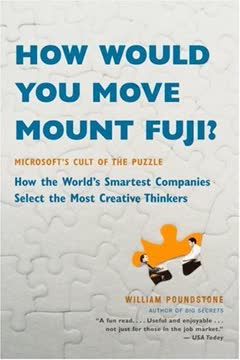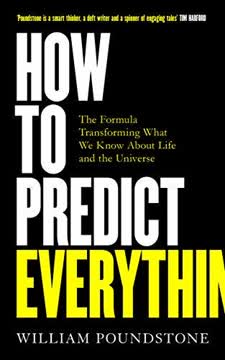Key Takeaways
1. Prices are arbitrary and malleable, not fixed or rational
"The numbers that make our world go around are not so solid, immutable, and logically grounded as they appear."
Coherent arbitrariness. Prices and economic values are largely arbitrary constructions, yet maintain internal consistency. Consumers lack an innate sense of what things should cost, instead relying on relative comparisons and contextual cues. This "coherent arbitrariness" means prices can be manipulated, yet still follow predictable patterns.
Price cluelessness. Most people have very poor ability to judge absolute prices or values. Experiments show how easily influenced pricing decisions are by irrelevant anchors like social security numbers. Even experts like real estate agents are susceptible to arbitrary pricing influences. This malleability of perceived value has profound implications for economic behavior and policy.
2. Anchoring effects significantly influence pricing decisions
"The more you ask for, the more you get."
Powerful anchoring. The first number presented in a negotiation or decision process serves as a powerful anchor, dramatically influencing the final outcome. Even random, irrelevant numbers can serve as anchors. This effect is remarkably robust across many domains.
Strategic applications. Savvy negotiators and marketers exploit anchoring effects. Setting a high initial price or salary demand tends to lead to higher final values. Luxury retailers use ultra-expensive items as anchors to make other products seem reasonably priced by comparison. Understanding anchoring provides a significant advantage in pricing and negotiation.
- Experiment: Real estate agents' valuations were influenced by arbitrary listing prices
- Tactic: Car dealers often start with an inflated price to anchor negotiations
- Example: A $7,000 handbag makes a $2,000 bag seem more reasonable
3. Fairness perceptions shape economic behavior and pricing
"The gap between the behavior that people consider fair and the behavior that they expect in the marketplace tends to be rather small."
Fairness rules. People have strong intuitions about fair pricing and economic behavior, often at odds with pure market forces. These perceptions significantly impact real-world economic decisions and policies.
Practical implications. Understanding fairness perceptions is crucial for businesses and policymakers. Consumers may boycott companies perceived as unfair, even if prices are market-efficient. Policies that violate fairness norms may face backlash.
- People view raising prices due to increased demand as unfair
- Cutting wages is seen as less fair than equivalently reducing real wages through inflation
- Framing price changes in terms of removing a discount is more acceptable than raising prices
4. The ultimatum game reveals complex human decision-making
"The unpredictability and characteristic skewness of jury dollar awards is readily replicated under laboratory conditions."
Game mechanics. In the ultimatum game, one player proposes how to split a sum of money, and the other can accept or reject. Rejection means neither player gets anything. Rational economic theory predicts minimal offers and acceptance of any non-zero amount.
Revealing results. Actual play diverges significantly from economic predictions. Proposers often offer close to 50/50 splits, and responders frequently reject "unfair" offers, even at personal cost. This demonstrates how notions of fairness, reciprocity, and punishment override pure economic rationality.
- Cross-cultural studies show some variation, but similar patterns globally
- Neuroimaging reveals emotional responses to unfair offers
- Variations like the dictator game further explore prosocial motivations
5. Context and framing dramatically impact financial choices
"We choose between descriptions of options, rather than between the options themselves."
Framing effects. How choices are presented profoundly influences decision-making, even when the underlying economics are identical. This challenges the notion of stable preferences central to traditional economic theory.
Real-world impact. Understanding framing effects is crucial for policymakers, marketers, and individuals. Small changes in how options are described can lead to dramatically different choices and outcomes.
- Experiment: Describing ground beef as "75% lean" vs "25% fat" changes perceptions
- Application: Opt-out vs opt-in framing for retirement savings plans significantly impacts enrollment
- Example: Reframing a $10 discount as avoiding a $10 fee increases its perceived value
6. Psychological factors often override economic rationality
"Incoherence is more than skin deep."
Bounded rationality. Human decision-making is constrained by cognitive limitations, emotions, and social factors. This leads to systematic deviations from pure economic rationality.
Heuristics and biases. People rely on mental shortcuts (heuristics) that can lead to predictable errors (biases). Understanding these patterns is crucial for predicting and influencing economic behavior.
- Availability heuristic: Judging probability based on ease of recall
- Endowment effect: Overvaluing what we already possess
- Loss aversion: Losses loom larger than equivalent gains
- Sunk cost fallacy: Continuing investment due to past expenditures
7. Behavioral economics challenges traditional economic theories
"At issue here is just how malleable decision processes might be, and whether there is some reality constraint on the extent to which such processes can be influenced."
Paradigm shift. Behavioral economics integrates psychological insights into economic analysis, challenging core assumptions of traditional economic models. This approach provides more accurate predictions and explanations of real-world behavior.
Policy implications. Behavioral economics insights are increasingly applied to public policy, from "nudge" interventions to redesigning economic incentives. This represents a significant departure from purely rational-actor based policymaking.
- Challenge to rational expectations theory in macroeconomics
- Questioning the efficiency of financial markets
- Rethinking models of consumer choice and demand
8. Money primes self-sufficiency and reduces prosocial behavior
"Priming effects may provide one of the mechanisms by which culture works."
Money effects. Mere exposure to money-related concepts increases self-sufficiency and reduces helping behavior. This occurs even without conscious awareness of the priming.
Cultural implications. The pervasiveness of money in modern societies may have far-reaching effects on social behavior and cultural norms. This raises questions about the unintended consequences of highly monetized cultures.
- Experiment: Subjects exposed to money images were less likely to help others
- Application: Workplace design incorporating money imagery may reduce teamwork
- Consideration: Potential negative social impacts of cashless societies
9. Pricing strategies exploit cognitive biases and heuristics
"Pricing is a dangerous lever."
Strategic pricing. Businesses leverage psychological insights to develop pricing strategies that maximize profits. This often involves exploiting cognitive biases and decision-making shortcuts.
Consumer awareness. Understanding these tactics can help consumers make more informed decisions and potentially resist manipulation. However, many of these effects operate subconsciously and are difficult to overcome.
- Charm pricing: Using prices ending in 9 (e.g., $9.99 instead of $10)
- Decoy pricing: Introducing an inferior option to make the target option seem more attractive
- Bundling: Combining products to obscure individual item values
- Price anchoring: Using a high initial price to make discounts seem more appealing
Last updated:
FAQ
What's Priceless: The Myth of Fair Value about?
- Explores pricing psychology: The book examines how consumers perceive prices and the psychological tricks that influence their willingness to pay.
- Behavioral economics focus: It integrates concepts from behavioral economics, particularly the work of Kahneman and Tversky, to explain irrational financial decisions.
- Real-world applications: The author uses examples like the McDonald’s coffee case and Super Bowl ticket pricing to illustrate pricing strategies.
Why should I read Priceless: The Myth of Fair Value?
- Understanding consumer behavior: Essential for those interested in marketing, economics, or psychology, revealing factors driving consumer decisions.
- Practical insights for businesses: Offers valuable strategies for setting prices effectively and understanding customer perceptions.
- Engaging storytelling: Complex concepts are presented in an accessible and entertaining manner, making it enjoyable for all readers.
What are the key takeaways of Priceless: The Myth of Fair Value?
- Value is subjective: Perceived value is often arbitrary and context-driven, not an absolute measure.
- Anchoring effect: Initial exposure to a number influences subsequent judgments, affecting perceived affordability.
- Loss aversion: People feel losses more acutely than equivalent gains, impacting responses to pricing changes.
What are the best quotes from Priceless: The Myth of Fair Value and what do they mean?
- “The more you ask for, the more you get.” Highlights that higher initial demands can lead to better outcomes in negotiations.
- “Prices are made-up numbers that don’t always carry much conviction.” Reflects the theme that consumer perceptions are often influenced by arbitrary factors.
- “Anchoring can’t happen to me.” Illustrates the misconception that individuals are immune to cognitive biases.
How does Priceless explain the anchoring effect?
- Anchoring defined: A cognitive bias where initial information influences subsequent judgments and decisions.
- Impact on pricing decisions: Consumers often base perceptions of value on initial price anchors, skewing willingness to pay.
- Real-world examples: High initial prices can make subsequent lower prices seem like bargains, manipulating consumer behavior.
What is the concept of "coherent arbitrariness" in Priceless?
- Definition of coherent arbitrariness: Consumers have stable relative valuations, but absolute price judgments are arbitrary.
- Example in pricing: Changes in product packaging without price alteration can maintain perceived value.
- Implications for businesses: Allows manipulation of value perceptions through strategic pricing and packaging.
What role does loss aversion play in consumer pricing according to Priceless?
- Understanding loss aversion: People experience losses more intensely than equivalent gains, affecting reactions to price changes.
- Impact on pricing strategies: Businesses can frame offers to emphasize potential losses, encouraging purchases.
- Examples in marketing: Creating urgency by highlighting potential losses can drive consumer action.
How does Priceless relate to the concept of fairness in pricing?
- Fairness perceptions: Consumers often reject offers perceived as unfair, even if financially beneficial.
- Experiments on fairness: The ultimatum game shows people sacrifice financial gain to punish perceived unfairness.
- Implications for businesses: Setting prices that are perceived as fair fosters loyalty and repeat business.
What is the significance of the ultimatum game in Priceless?
- Definition of the ultimatum game: A bargaining scenario where one player proposes a division of money, and the other can accept or reject it.
- Findings from the game: People often reject unfair offers, showing emotions and social norms in economic decisions.
- Broader implications: Highlights the importance of perceived fairness in negotiation dynamics and consumer behavior.
What is the concept of transaction utility in Priceless: The Myth of Fair Value?
- Definition of transaction utility: Perceived value of a purchase compared to its price, influencing decision-making.
- Positive and negative utility: Positive utility leads to purchases; negative utility results in rejection.
- Real-life implications: Helps businesses set prices that maximize consumer satisfaction and sales.
How can I apply the lessons from Priceless: The Myth of Fair Value in my daily life?
- Be aware of anchors: Evaluate products based on actual worth rather than initial prices.
- Evaluate transaction utility: Assess whether a price feels like a bargain or a rip-off.
- Negotiate effectively: Use fairness and emotional responses to craft offers perceived as fair.
What role do emotions play in pricing decisions according to Priceless: The Myth of Fair Value?
- Emotional responses to pricing: Emotions significantly influence perceptions and decisions, with feelings of outrage affecting willingness to buy.
- Loss aversion: People react more strongly to high prices than low prices, impacting purchasing behavior.
- Balancing emotions and rationality: Understanding emotional aspects helps businesses create resonant strategies.
Review Summary
Priceless explores the psychology of pricing, revealing how irrational and manipulable our perception of value can be. Readers found the book's insights into behavioral economics fascinating, particularly concepts like anchoring and prospect theory. Many appreciated the real-world examples and practical applications. Some felt the book was dense or repetitive, while others praised its thoroughness. Overall, reviewers found the book eye-opening, though opinions varied on its readability and structure. Most agreed it offers valuable insights for both consumers and business professionals.
Similar Books









Download PDF
Download EPUB
.epub digital book format is ideal for reading ebooks on phones, tablets, and e-readers.










